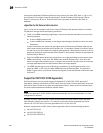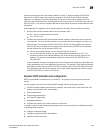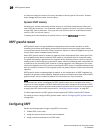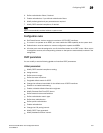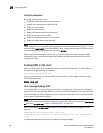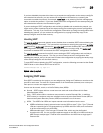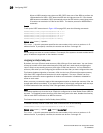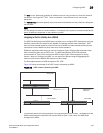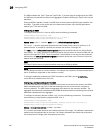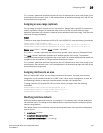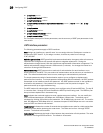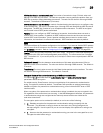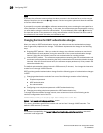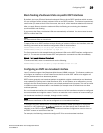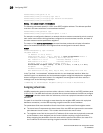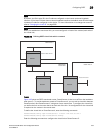
936 PowerConnect B-Series FCX Configuration Guide
53-1002266-01
Configuring OSPF
29
The ABR translates the Type-7 LSAs into Type-5 LSAs. If an area range is configured for the NSSA,
the ABR also summarizes the LSAs into an aggregate LSA before flooding the Type-5 LSAs into the
backbone.
Since the NSSA is partially “stubby” the ABR does not flood external LSAs from the backbone into
the NSSA. To provide access to the rest of the Autonomous System (AS), the ABR generates a
default Type-7 LSA into the NSSA.
Configuring an NSSA
To configure OSPF area 1.1.1.1 as an NSSA, enter the following commands.
PowerConnect(config)#router ospf
PowerConnect(config-ospf-router)#area 1.1.1.1 nssa 1
PowerConnect(config-ospf-router)#write memory
Syntax: area <num> | <ip-addr> nssa <cost> | default-information-originate
The <num> | <ip-addr> parameter specifies the area number, which can be a number or in IP
address format. If you specify a number, the number can be from 0 through 18.
The nssa <cost> | default-information-originate parameter specifies that this is a Not-So-Stubby
Area (NSSA). The <cost> specifies an additional cost for using a route to or from this NSSA and can
be from 1 through 16777215. There is no default. Normal areas do not use the cost parameter.
Alternatively, the default-information-originate parameter causes the Layer 3 Switch to inject the
default route into the NSSA.
NOTE
The Layer 3 Switch does not inject the default route into an NSSA by default.
NOTE
You can assign one area on a router interface. For example, if the system or chassis module has 16
ports, 16 areas are supported on the chassis or module.
To configure additional parameters for OSPF interfaces in the NSSA, use the ip ospf area…
command at the interface level of the CLI.
Configuring a summary address for the NSSA
If you want the ABR that connects the NSSA to other areas to summarize the routes in the NSSA
before translating them into Type-5 LSAs and flooding them into the other areas, configure a
summary address. The ABR creates an aggregate value based on the summary address. The
aggregate value becomes the address that the ABR advertises instead of advertising the individual
addresses represented by the aggregate.
To configure a summary address in NSSA 1.1.1.1, enter the following commands. This example
assumes that you have already configured NSSA 1.1.1.1.
PowerConnect(config)#router ospf
PowerConnect(config-ospf-router)#summary-address 209.157.22.1 255.255.0.0
PowerConnect(config-ospf-router)#write memory
Syntax: [no] summary-address <ip-addr> <ip-mask>
The <ip-addr> parameter specifies the IP address portion of the range. The software compares the
address with the significant bits in the mask. All network addresses that match this comparison
are summarized in a single route advertised by the router.



